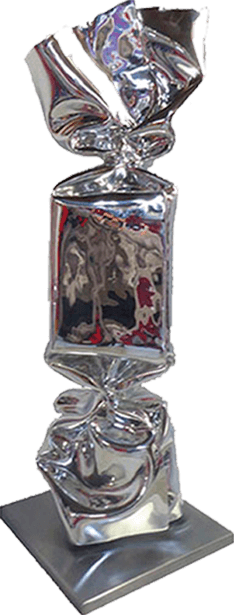

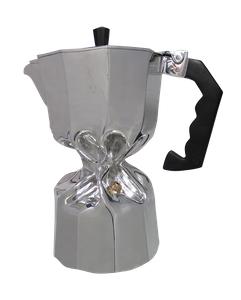



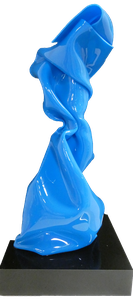
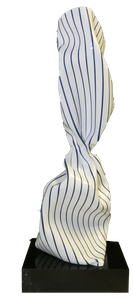
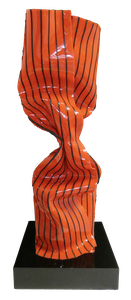
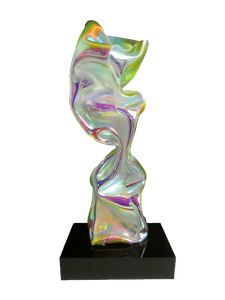
The new work of art by Laurence Jenkell:
Wrapping Coffee Maker sculpture
Aa a big coffee drinker, Laurence Jenkell has chosen to create a Wrapping Coffee Maker sculpture to pay tribute to this iconic drink consumed around the world and knowned to everyone. She choose the most famous in the world, the Moka coffee maker, also known as the Italian coffee maker or macchinetta. Since its creation in 1933, this coffee maker has become an icon, a design object exhibited in museums. After water, coffee is the second most consumed drink in the world, with two out of three people drinking coffee. In addition to its aroma and special taste, this drink has virtues that justify its consumption around the world (morning coffee to wake up, midday coffee, coffee breaks etc).
Yesterday’s coffee maker no longer resembles todays’ machines and yet throughout the world each family has its own ritual. Not just in the choice of coffee types, origins, roasting, beans or grind, but also the coffee maker itself. Making coffee is an art, tasting it and appreciating it is also an art. It is a ritual rooted in morals and time. Tasting it is a pleasure that we like to share, a true moment of conviviality and relaxation. It is hard to imagine a world without coffee but by making this Coffee Maker Wrapping, Laurence Jenkell is raising a cry of alarm as she applies her famous twist to the artwork to raise awareness that this drink will not always exist. Wild coffee is threatened with extinction. Arabica is in decline. Robusta, which is well named, is resisting better and will undoubtedly be the coffee of the future, when world production will have dropped by half, in 2050.
The artist choose to make her Coffee Maker Wrapping sculpture out of aluminium, paying tribute to its creator, Alfonso Bialetti who used aluminium to make the body of his coffee maker, which was very innovative at the time. Twisted in a polished aluminium casting, Laurence Jenkell elevates her Coffee Maker Wrapping sculpture to a work of art, enhancing the iconic coffee maker.
The new work of art by Laurence Jenkell:
The Elephant Sculpture "Jelly Wrap"
I choose the elephant because it symbolizes strength. The pressure and the act of torsion that I applied to its body expresses a radical gesture of refusal towards what the animal world is going through today.
Not only do I revolt against the famine faced by animals in some countries, and even in some communities, but also more generally against the abuse they suffer from (abuse, violence, poaching, etc).
As an artist, I consider it to be my duty to denounce this critical situation: 300,000 elephants are killed each year in Africa in which 50,000 are slaughtered for their tusks.
Through this work I also speak out about the environment issues and global warming that affects water resources. With my Wrapping Elephant I have taken a position for the animal cause. Unlike poachers, I artistically mistreated the elephant, twisting its stomach to shock public opinion and raise awareness.
I choose to create my subject in a noble material for the Elephant King, the aluminium polybrillant which adds strength to my twist and magnifies the work as a jewel thus referring to the illegal trade of the animal’s tusks used to make ivory jewelry.
The new work of art by Laurence Jenkell:
Wrapping Fridge sculpture
Medias show us on a daily basis starvation images that cannot leave us insensitive. A humanitarian drama takes place before our eyes (for example in South Sudan or Somalia) and we are feeling powerless against those tragedies. More than 30 million people are in emergency food or threatened by famine. Whole villages are empty and people flee from war or drought, sometimes both.
Laurence Jenkell does not pretend to stem these scourges but with her art she expresses her refusal of powerlessness and tries to sensitize peoples with a artwork that is internationally strongly noticeable to everyone.
Even if the artist refuses to make politics, she can’t help herself from reacting to environmental problems, nor to an economic and political reality. She uses an ordinary everyday object, the refrigerator, more commonly called « Frigidaire » from the name of its inventor. This object is the very symbol of the consumer society and also the symbol of success in some countries.
By creating a Wrapping Fridge sculpture, Laurence Jenkell seeks to raise awareness of global warming and destruction of the ozone layer in the stratosphere.
The artist used a real refrigerator and asked a specialist technician to remove the gas without any leakage. With the Frigidaire thus twisted, the artist makes a parallel with the ice of the freezer which melted (and the melting of the snows due to the global warming) and adds another symbol through refrigerator’s half opened door, as if the Wrapping Frigidaire itselt wanted to cool down the planet.
When somebody is hungry, his first move will be to open his so called « Frigidaire », and only if hus is lucky enough to own one. The Wrapping Refrigerator sculpture is a call from the artist for a raise of awareness. It is radical gesture of rejection against a reality that we impose ourselves and an international crisis that we are experiencing. The twist that the Artist applies to her « Frigidaire » symbolizes the fact that everyone is now forced to stitch his belt, deprive himself, reduce his expenses, his way of life. The very act of twisting is a voluntary and powerful act in which the artist uses her whole self being to express her disagreement and her refusal. She thus magnifies the refrigerator object which she elevates to the level of Art piece. The will to realize the Wrapping Refrigerator sculpture in Aluminum polybrillant material and its perfect finish makes of this banal and usual object an iconic work of art resembling a goldsmith’s finished piece.
Monaco: Laurence Jenkell exhibits her artworks at the Grimaldi Forum and presents in preview her new artwork about environment:
Wrapping Trash Can sculpture.
Laurence Jenkell reveals her inner self as well as her feelings about world nowadays.
By creating a polibrillant Aluminum garbage can sculpture on which she applies her famous twist, it is her whole being merging into her artwork. Her artwork marks her time and is part of a visionary research on the current world we live in.
With her Wrapping trash can sculpture, Laurence Laurence Jenkell takes a stand on topical issues, the evolution of our consumer society and even overconsumption, waste, environment, hunger in the world etc. It brings up the debate on poignant subjects such as waste in the oceans, open-air dumps, etc. and raises other issues such as global warming. It upgrades the garbage can, redesigns it, reinvents and gives it a new meaning. She re-interprets the trash can, gives it a cultural and intellectual dimension and makes it an object of art, covetousness and desire for appropriation.

